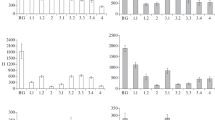Abstract
Decomposition of preparations of various fractions of fulvio acids in pure cultures of bacteria and in the soil was investigated. In the soils enriched with fulvic acids the amount of bacteria increased, oxygen consumption and formation of carbon dioxide followed a typical sigmoid curve. The above measurements indicated that mineralization occurred after a very short or negligible lag phase. During the decomposition of fulvic acids the ability of microorganisms to oxidize aromatic compounds,e.g. vanillio andphydroxybenzoic acid, increased. The presence of aromatic structures in the used preparations of fulvic acids was demonstrated on the basis of their IR spectra and according to the results of Chromatographic analyses of their hydrolysates. The results indicated a relationship between metabolism offulvio acids and aromatic oompounds. In samples of the soil preincubated with glucose the fulvic acids decomposed more rapidly than in untreated samples.
Similar content being viewed by others
References
Alexandbova I. V.: On the role of microbial metabolites during the formation of humic substances. RussianPochvovedenije No.8. 71 (1968).
Audus L. J.: A new soil perfusion apparatus.Nature 158, 419 (1946).
Bremner J. M., Shaw K.: Denitrification of soil. I. Methods of investigation.J. Agr. Sci. 51, 22 (1958).
Burges N. A.: Biological processes in the decomposition of organic matter. In: E. G. Hallsworth, D. V. Crawford (Eds.):Experimental Pedology. Publ. Butterworths, London, 1964, p. 189.
Burges A., Latter P.: Decomposition of humic acid by fungi.Nature 186, 404 (1960).
DeBorger R.: Note sur la détermination du caractére aromatique des acides humiques et fulviques.Compt. Rend. D 269, 1564 (1969).
DeBorger R.: Le dégagement de CO2 lors de la décomposition microbiologique des acides fulviques.Compt. Rend. D 274, 2104 (1972).
Drobník J.: A Warburg vessel for soil samples.Nature 188. 686 (1960).
Fedorov M. V., Ilyina T. K.: Utilization of humic acids by soil actinomycetes as the only source of carbon and nitrogen. (In Russian)Mikrobiologiya 32, 272 (1963).
Grunda B.: The effect of humus substances on the count of soil microorganisms in culture.Folia Microbiol. 15, 216 (1970).
Hais I. M., Macek K. (Eds.):Paper Chromatography. Publ. House of the Czechoslovak Academy of Sciences, Prague, 1963.
Hurst H. M.: Aromatic acid-reducing systems in fungi. In: Pridham J. B. (Ed.):Enzyme Chemistry of Phenolic Compounds. Proceedings of Plant Phenolic Group Symposium. Pergamon Press, London, 1963, p. 121.
Hurst H. M., Burges N. A.: Lignin and humic acids. In: McLaren A. D., Peterson G. H. (Eds.):Soil Biochemistry. M. Dekker, New York 1967, p. 260.
Hurst H. M., Burges A., Latter P.: Some aspects of the biochemistry of humic acid decomposition by fungi.Phytochemistry 1, 227 (1962).
Jakab T., Dubach P., Mehta N. C., Deuel H.: Abbau von Huminstoffen. I. Hydrolyse mit Wasser und Mineralsäuren.Z. Pflanzenernäh. Düng., Bodenk. 96, 213 (1962).
Jansson S. K.: On the establishment and use of tagged microbial tissue in soil organic matter research. 7thIntern. Congt. Soil. Sci., Madison, Wisc., USA, III.25, 635 (1960).
Johnston H. H.: Soil organic matter. II. Studies on the origin and chemical structure of soil humic acids.Soil Sci. Soc. Amer. Proc. 25, 32 (1961).
Kononova M. M.:Soil Organic Matter. Pergamon Press, London, 1961, p. 74.
Kunc F., Macura J.: Oxidation of aromatic compounds in soil.Folia Microbiol. 11, 248 (1966).
Latter P., Burges A.: Experimental decomposition of humic acid by fungi.7th Intern. Congr. Soil Sci., Madison, Wisc., USA26, 643 (1960).
Macura J., Szolnoki J., Kunc F., Vančura V., Babický A.: Decomposition of glucose continuously added to soil.Folia Microbiol. 10, 44 (1965).
Mathur S. P.: Microbial use of podzol Bh fulvic acids.Can. J. Microbiol. 15, 677 (1969).
Mathur S. P., Paul E. A.: A microbiological approach to the problem of soil humic acid structures.Nature 212, 646 (1966).
Mishustin E. N., Nikitin D. I.: Decomposition of humic acids by the soil microflora. (In Russian)Mikrobiologiya 30, 841 (1961).
Mortensen J. L., Himes F. L.: Soil organic matter. In: Bear F. E. (Ed.):Chemistry 0f the Soil. Amer. Chem. Soc. Mono 160, Rheinhold Publ. Comp., New York, 1964, p. 224.
Mrysha G. N.: Utilization of nitrogen of humic compounds by soil micro-organisms. (In Russian)Izv. Timiryazev. Sel.-Choz. Acad. No. 5, 46 (1966).
Mrysha G. N.: Micro-organisms of the genusPseudomonas utilizing humic acids of soils. (In Russian)Izv. Timiryazev. Sel.-Choz. Acad., No.2, 35 (1967).
Mrysha G. N.: Micro-organismsof Pseudomonas genus growing on humin compounds. (In Russian)Mikrobiologiya 38, 492 (1969).
Murzakov B. G., Vasilyeva L. V.: Decomposition of fulvic acids fractions by soil microflora. (In Russian)Izv. AN USSR, Ser. Biol., No.10, 906 (1970).
Najmr S., Cikánek M.: Simultaneous determination of carbon and nitrogen in soil. (In Czech)Sborník ČSAZV A 26, 285 (1953).
Nikitin D. I.: Decomposition of soil humic acids by microorganisms. (In Russian)Izv. AN USSR, Ser. Biol. No.4, 618 (1960).
Nikitin D. I., Vasilyeva L. V., Lokhmacheva R. A.: New and rare forms of soil micro organisms. (In Russian) Nauka, Moscow, 1966.
Orlov D. S.: Humic acids of soil. (In Russian) Publ. House of Moscow University, Moscow 1974.
Shivrina A. N., Rydalevskaya M. D., Tereshenkova I. A.: On aromatic compounds as components of humus acids. (In Russian)Pochvovedenie No.1, 65 (1968).
Taylor C. B.: The nutritional requirements of predominant flora of the soil.Proc. Soc. Appl. Bact. 14, 101 (1951).
Viljams V. V.: The separation and quantitative determination of soil humic acids. (In Russian)Izv. Timiryazev. Sel.-Choz. Acad. No.2, 126 (1965).
Author information
Authors and Affiliations
Rights and permissions
About this article
Cite this article
Kunc, F., Lokhmacheva, R.A. & Macura, J. Biological decomposition of fulvic acid preparations. Folia Microbiol 21, 257–267 (1976). https://doi.org/10.1007/BF02876901
Received:
Issue Date:
DOI: https://doi.org/10.1007/BF02876901



